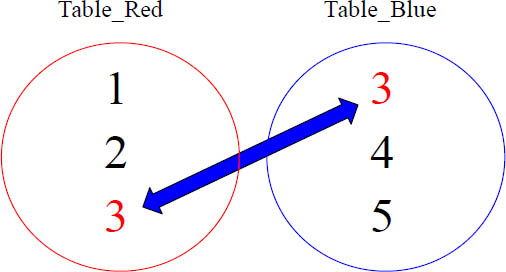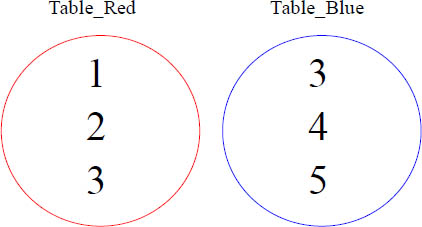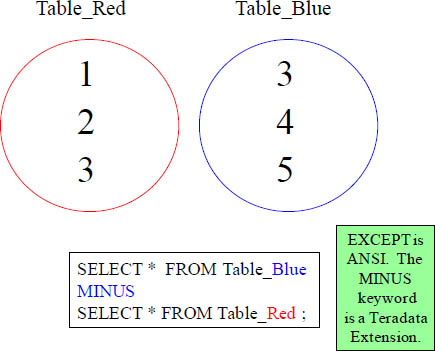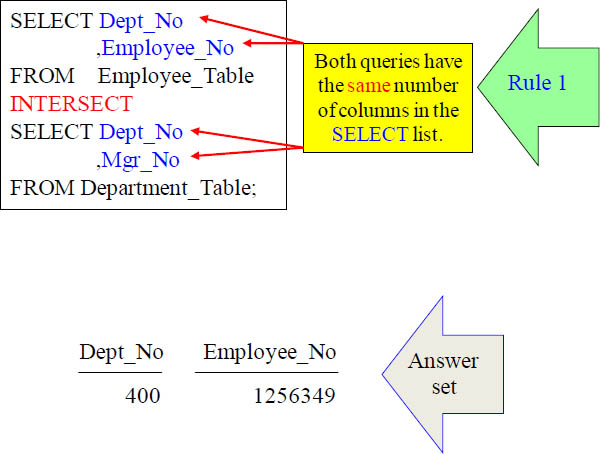Chapter 16 – Set Operators Functions
"The man who doesn't read good books has no advantage over the man who can't read them."
-Mark Twain
Rules of Set Operators
1.Each query will have at least two SELECT Statements separated by a SET Operator
2.SET Operators are UNION, INTERSECT, or EXCEPT/MINUS
3.Must specify the same number of columns from the same domain (data type/range)
4.If using Aggregates, both SELECTs much have their own GROUP BY
5.Both SELECTS must have a FROM Clause
6.The First SELECT is used for all ALIAS, TITLE, and FORMAT Statements
7.The Second SELECT will have the ORDER BY statement which must be a number
8.When multiple operators the order of precedence is INTERSECT, UNION, and EXCEPT/MINUS
9.Parentheses can change the order of Precedence
10.Duplicate rows are eliminated in the spool unless the ALLkeyword is used
Rules of Set Operators
Each query will have at least two SELECT Statements separated by a SET Operator
SET Operators are UNION, INTERSECT, or EXCEPT/MINUS
Must specify the same number of columns from the same domain (data type/range)
If using Aggregates, both SELECTs much have their own GROUP BY
Both SELECTS must have a FROM Clause
The First SELECT is used for all ALIAS, TITLE, and FORMAT Statements
The Second SELECT will have the ORDER BY statement, which must be a number
When multiple operators the order of precedence is INTERSECT, UNION, and EXCEPT/MINUS
Parentheses can change the order of Precedence
Duplicate rows are eliminated in the spool, unless the ALL keyword is used
INTERSECT Explained Logically

SELECT * FROM Table_Red
INTERSECT
SELECT * FROM Table_Blue ;
In this example, what numbers in the answer set would come from the query above ?
INTERSECT Explained Logically

SELECT * FROM Table_Red
INTERSECT
SELECT * FROM Table_Blue ;
3
In this example, only the number 3 was in both tables so they INTERSECT.
UNION Explained Logically

SELECT * FROM Table_Red
UNION
SELECT * FROM Table_Blue ;
In this example, what numbers in the answer set would come from the query above ?
UNION Explained Logically

SELECT * FROM Table_Red
UNION
SELECT * FROM Table_Blue ;
1 2 3 4 5
Both top and bottom queries run simultaneously, then the two different spools files are merged to eliminate duplicates and place the remaining numbers in the answer set.
UNION ALL Explained Logically

SELECT * FROM Table_Red
UNION ALL
SELECT * FROM Table_Blue ;
In this example, what numbers in the answer set would come from the query above ?
UNION Explained Logically

SELECT * FROM Table_Red
UNION ALL
SELECT * FROM Table_Blue ;
1 2 3 3 4 5
Both top and bottom queries run simultaneously, then the two different spools files are merged together to build the answer set. The ALL prevents eliminating Duplicates.
EXCEPT Explained Logically

SELECT * FROM Table_Red
EXCEPT
SELECT * FROM Table_Blue ;
EXCEPT and MINUS do the exact same thing so either word will work!
In this example, what numbers in the answer set would come from the query above ?
EXCEPT Explained Logically

SELECT * FROM Table_Red
EXCEPT
SELECT * FROM Table_Blue ;
1 2
The Top query SELECTED 1, 2, 3 from Table_Red. From that point on, only 1, 2, 3 at most could come back. The bottom query is run on Table_Blue, and if there are any matches, they are not ADDED to the 1, 2, 3 but instead take away either the 1, 2, or 3.
Minus Explained Logically

EXCEPT and MINUS do the exact same thing, so either word will work
What will the answer set be? Notice I changed the order of the tables in the query!
Minus Explained Logically

SELECT * FROM Table_Blue
MINUS
SELECT * FROM Table_Red ;
4 5
The Top query SELECTED 3, 4, 5 from Table_Blue. From that point on, only 3, 4, 5 at most could come back. The bottom query is run on Table_Red, and if there are any matches, they are not ADDED to the 3, 4, 5 but instead take away either the 3, 4, or 5.
Testing Your Knowledge

Will the result set be the same for both queries above?
Will both queries bring back the exact same result set? Check out the next page to find out.
Answer - Testing Your Knowledge

Will the result set be the same for both queries above?
Yes
Both queries above are exactly the same to the system and produce the same result set.
Testing Your Knowledge

Will the result set be the same for both queries above?
Will both queries bring back the exact same result set? Check out the next page to find out.
Answer - Testing Your Knowledge

Will the result set be the same for both queries above?
No! The first query returns 4, 5, and the query on the right returns 1, 2.
An Equal Amount of Columns in both SELECT List

You must have an equal amount of columns in both SELECT lists. This is because data is compared from the two spool files, and duplicates are eliminated. So, for comparison purposes, there must be an equal amount of columns in both queries.
Columns in the SELECT list should be from the same Domain

The above query works without error, but no data is returned. There are no First Names that are the same as Department Names. This is like comparing Apples to Oranges. That means they are NOT in the same Domain.
The Top Query handles all Aliases

The Top Query is responsible for ALIASING.
The Bottom Query does the ORDER BY (a Number)

The Bottom Query is responsible for sorting, but the ORDER BY statement must be a number, which represents column1, column2, column3, etc.
Great Trick: Place your Set Operator in a Derived Table
SELECT Employee_No AS MANAGER
,Trim(Last_Name) || ', ' || First_Name as "Name"
FROM Employee_Table
INNER JOIN
(SELECT Employee_No
FROM Employee_Table
INTERSECT
SELECT Mgr_No
FROM Department_Table)
AS TeraTom (empno)
ON Employee_No = empno
ORDER BY "Name"
MANAGER |
Name |
1256349 |
Harrison, Herbert |
1333454 |
Smith, John |
1000234 |
Smythe, Richard |
1121334 |
Strickling, Cletus |
The Derived Table gave us the empno for all managers, and we were able to join it.
UNION Vs UNION ALL
SELECT Department_Name, Dept_No
FROM Department_Table
UNION ALL
SELECT Department_Name, Dept_No
FROM Department_Table
ORDER BY 1;

UNION eliminates duplicates, but UNION ALL does not.
Using UNION ALL and Literals

Notice the 2nd SELECT column in that it is a literal ‘Employee ‘ (with two spaces) and the other Literal is ‘Department’. These literals match up because now they are both 10 characters long exactly. The UNION ALL brings back all Employees and all Departments and shows the employees in each valid department.
A Great Example of how EXCEPT works

SELECT Dept_No as Department_Number
FROM Department_Table
EXCEPT
SELECT Dept_No
FROM Employee_Table
ORDER BY 1 ;
Department_Number
500
This query brought back all Departments without any employees.
USING Multiple SET Operators in a Single Request

Above we use multiple SET Operators. They follow the natural Order of Precedence in that UNION is evaluated first, then INTERSECT, and finally MINUS.
Changing the Order of Precedence with Parentheses

Above we use multiple SET Operators and Parentheses to change the order of precedence. Above the EXCEPT runs first, then the INTERSECT and lastly, the UNION. The natural Order of Precedence without parentheses is UNION, INTERSECT, and finally EXCEPT or MINUS.
Using UNION ALL for speed in Merging Data Sets

Because the Combined_Custs table started empty there is no Transient Journal taking pictures for Rollback purposes so this dramatically increases the speed. This one transaction sees both SELECT statements run in parallel and then merge into one.
Using UNION to be same as GROUP BY GROUPING SETS

